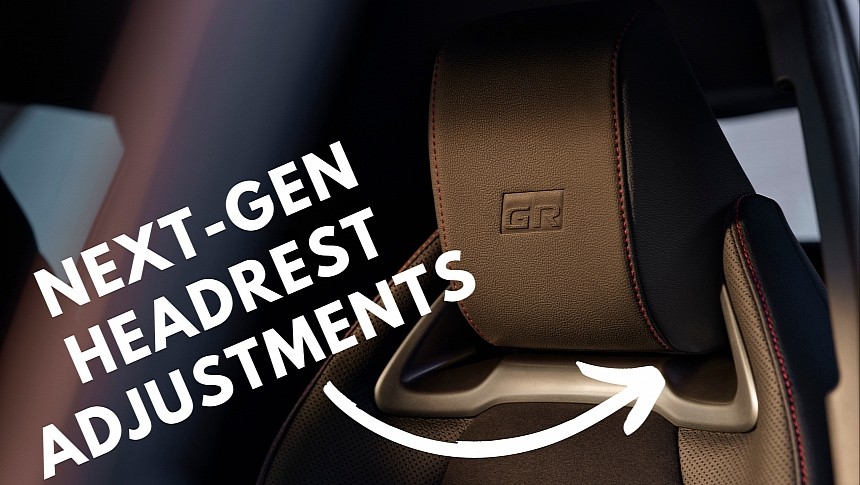We've all been there. Adjusting the headrest, especially in a new car, is often a pain in the neck, as we must reach our arms and hands behind the body or the head and neck specifically to press the release button.
The method is complicated and frustrating, especially in a shared car where the driver must adjust the headrest regularly.
If you and your significant other drive the same car, you'll have to do this every time you get behind the wheel after she goes to the supermarket. Eventually, you'll get used to the system, but Toyota believes there's a way to make the process more convenient.
The Japanese carmaker has envisioned a new technology relying on gestures to detect when you want to adjust the headrest. The company says it can integrate sensors into the headrest for various adjustments – for example, the system can determine when you want to increase or decrease the height or the angle relative to the seat.
Toyota's patent (called "systems and methods for improving the adjustment of a vehicle headrest using gestures") revolves around the locking mechanism that car passengers must activate to control the headrest's configuration. The carmaker says it's sometimes too difficult to press this button, so using gestures can activate the adjustment mode automatically.
Simply enabling this option doesn't significantly overhaul the process. Still, Toyota already described more advanced systems where the sensors employed for gesture detection run with power-assisted technology embedded into the headrest. Once the system detects your intention of adjusting the headrest, it can activate the mode by releasing the lock and then allow you to change the position more conveniently using power controls.
The force sensors integrated into the headrest come into play when you conduct specific moves – for example if you try to increase the headrest's height, a motor can kick in, moving the headrest to the next pre-configured height level.
Toyota says the technology can rely on all kinds of sensors installed in the car, as the main objective is to accurately detect when a car passenger wants to adjust the headrest. As a result, it can use sensors and cameras, including driver monitoring systems integrated into the cabin. Eventually, once the system kicks in, it generates a notification, letting you know that you can adjust the headrest according to your settings.
The system fits certain cars like a glove, such as those used by ride-hailing platforms, taxis, or autonomous vehicles where passengers might change their seating position.
Toyota's proposal is in the patent stage, and if you're familiar with how these filings work, you probably know already that we're still far from when mass production could begin. There's no guarantee the Japanese automaker will ever bring its idea to a model available for purchase, so you'd better not hold your breath to try it out live.
If you and your significant other drive the same car, you'll have to do this every time you get behind the wheel after she goes to the supermarket. Eventually, you'll get used to the system, but Toyota believes there's a way to make the process more convenient.
The Japanese carmaker has envisioned a new technology relying on gestures to detect when you want to adjust the headrest. The company says it can integrate sensors into the headrest for various adjustments – for example, the system can determine when you want to increase or decrease the height or the angle relative to the seat.
Toyota's patent (called "systems and methods for improving the adjustment of a vehicle headrest using gestures") revolves around the locking mechanism that car passengers must activate to control the headrest's configuration. The carmaker says it's sometimes too difficult to press this button, so using gestures can activate the adjustment mode automatically.
Simply enabling this option doesn't significantly overhaul the process. Still, Toyota already described more advanced systems where the sensors employed for gesture detection run with power-assisted technology embedded into the headrest. Once the system detects your intention of adjusting the headrest, it can activate the mode by releasing the lock and then allow you to change the position more conveniently using power controls.
The force sensors integrated into the headrest come into play when you conduct specific moves – for example if you try to increase the headrest's height, a motor can kick in, moving the headrest to the next pre-configured height level.
Toyota says the technology can rely on all kinds of sensors installed in the car, as the main objective is to accurately detect when a car passenger wants to adjust the headrest. As a result, it can use sensors and cameras, including driver monitoring systems integrated into the cabin. Eventually, once the system kicks in, it generates a notification, letting you know that you can adjust the headrest according to your settings.
The system fits certain cars like a glove, such as those used by ride-hailing platforms, taxis, or autonomous vehicles where passengers might change their seating position.
Toyota's proposal is in the patent stage, and if you're familiar with how these filings work, you probably know already that we're still far from when mass production could begin. There's no guarantee the Japanese automaker will ever bring its idea to a model available for purchase, so you'd better not hold your breath to try it out live.
















